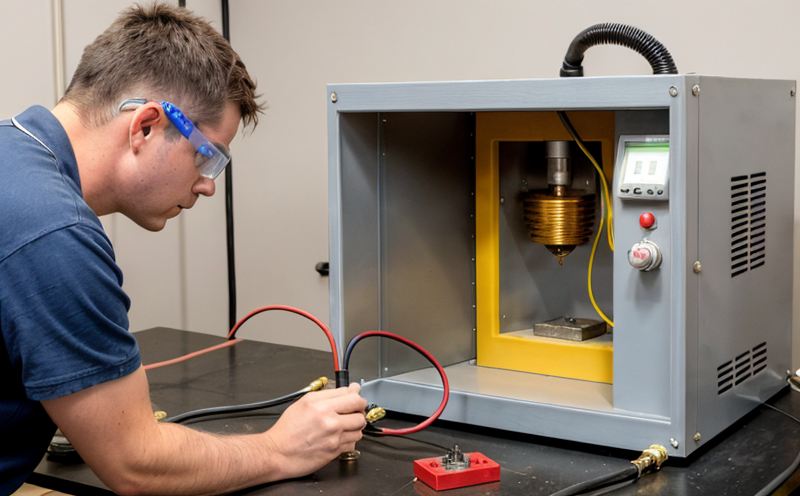ASTM A342 Magnetic Permeability of Materials
The ASTM A342 standard provides a precise method for measuring magnetic permeability in materials. This test is essential for understanding how different metals and alloys behave under magnetic fields, which is critical for both quality control and research and development (R&D) processes.
Magnetic permeability refers to the ability of a material to support or guide magnetic flux. Materials with high magnetic permeability can be strongly magnetized by an external magnetic field, making them useful in applications such as transformers, electromagnets, and sensors. Conversely, materials with low magnetic permeability act more like insulators and are used for shielding.
The ASTM A342 test is particularly significant because it allows metallurgists to understand how the microstructure of a metal or alloy affects its magnetic properties. This information can be vital in optimizing product performance, ensuring compliance with industry standards, and troubleshooting issues that arise during manufacturing processes.
During this test, a specimen is subjected to an alternating magnetic field, and the induced voltage (called eddy currents) is measured. The ratio of the applied magnetic flux density to the resulting magnetization within the material provides the permeability value. This process is conducted under controlled conditions to ensure accurate results.
The ASTM A342 method is widely used in various industries, including automotive, aerospace, and electronics, where the magnetic properties of materials play a crucial role in product design and performance. The test can help identify potential issues early on, ensuring that products meet stringent quality standards before they reach the market.
For R&D engineers, this test is invaluable for exploring new material compositions or modifications to existing alloys. Understanding how changes in chemical composition affect magnetic permeability can lead to innovations in product design and functionality. In procurement, this information helps ensure that materials purchased meet the required specifications, thereby reducing the risk of substandard components being used.
The ASTM A342 test is also crucial for compliance officers who must ensure that products comply with relevant safety standards. By using this test, they can verify that their materials are suitable for intended applications and meet necessary regulatory requirements.
Scope and Methodology
The ASTM A342 standard is designed to measure the magnetic permeability of ferromagnetic materials in the frequency range from 0.1 Hz to 1 MHz. It covers a wide variety of metals, including iron, nickel, cobalt, and their alloys.
For this test, a specimen is typically prepared by cutting it into small pieces or discs with dimensions that allow for accurate measurement. The specimen is then placed in the magnetic field generated by an alternating current (AC) source. The AC frequency used can vary depending on the specific application but commonly ranges from 5 kHz to 1 MHz.
The induced eddy currents are measured using a pickup coil, which is positioned close to the surface of the specimen. The voltage produced in this coil due to the changing magnetic flux through it is proportional to the permeability of the material. This voltage is then converted into permeability values by applying the appropriate formula.
The test apparatus used for ASTM A342 includes a high-quality AC power supply, a pickup coil, and a data acquisition system capable of recording the induced voltages accurately. Calibration of these instruments ensures reliable results.
Acceptance criteria for this test are based on the expected permeability values for the specific material being tested. These values can be found in reference materials or established industry standards. If the measured permeability falls outside the acceptable range, further investigation into the sample preparation and testing procedures is necessary.
Competitive Advantage and Market Impact
Understanding magnetic permeability through ASTM A342 can provide significant competitive advantages in several ways:
- Innovative Product Development: By identifying how changes in material composition affect magnetic properties, companies can innovate more effectively. This knowledge leads to better-performing products that can meet market demands.
- Cost Reduction: Ensuring compliance with standards early in the development process saves costs associated with rework or scrap due to non-compliance later on.
- Better Quality Control: Regular testing according to ASTM A342 helps maintain consistent product quality, enhancing customer satisfaction and loyalty.
- Regulatory Compliance: Demonstrating compliance with industry standards like ASTM A342 can open up new markets and opportunities for international sales.
In the global market, companies that excel in understanding magnetic permeability through this test are better positioned to meet customer expectations. They can offer products that perform well under various conditions, which is crucial in competitive environments.
Use Cases and Application Examples
| Application Example | Description |
|---|---|
| Automotive Transformers | Magnetic permeability testing ensures that transformers used in automotive electronics meet strict performance requirements, enhancing reliability. |
| Battery Cooling Systems | The right materials with optimal magnetic properties can improve the efficiency of battery cooling systems by guiding heat away from critical components. |
| Electromagnetic Interference Shielding | Metals with specific permeability values are used in shielding enclosures to protect sensitive electronics from electromagnetic interference. |
| Magnet Assembly Design | Determining the magnetic properties of materials helps engineers design more efficient and powerful magnet assemblies for various applications. |
| Electromagnetic Compatibility Testing | This test is crucial in ensuring that electronic devices do not interfere with each other's operation, which is essential for product safety and compliance. |
| Smart Sensors Calibration | Magnetic permeability plays a key role in the calibration of sensors used in various industries. Accurate calibration ensures precise measurements. |
The ASTM A342 test is also applicable to research and development efforts aimed at creating new materials with tailored magnetic properties. For instance, in aerospace applications, understanding how different alloy compositions affect permeability can lead to lighter, more efficient components that meet stringent performance criteria.
In the electronics industry, this test helps ensure that the materials used in the production of smart devices have the right magnetic properties for optimal performance and reliability.





